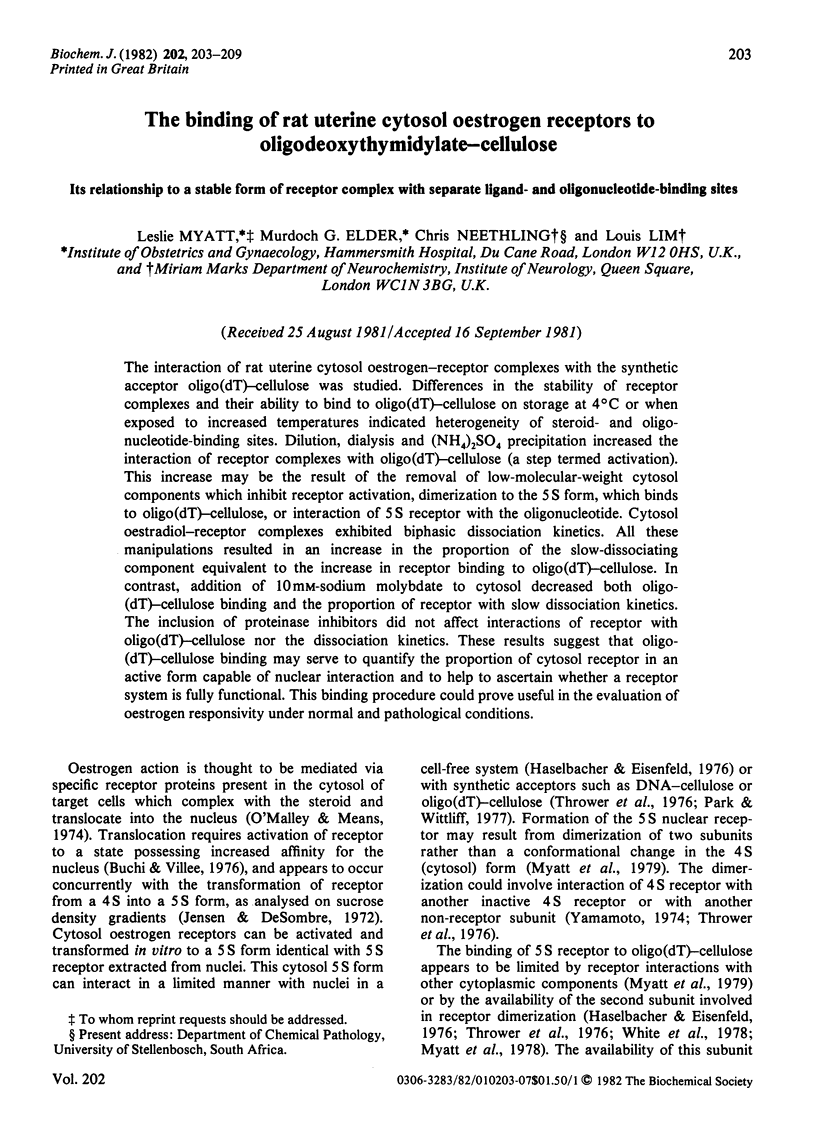Abstract
The interaction of rat uterine cytosol oestrogen-receptor complexes with the synthetic acceptor oligo(dT)--cellulose was studied. Differences in the stability of receptor complexes and their ability to bind to oligo(dT)--cellulose on storage at 4 degrees C or when exposed to increased temperatures indicated heterogeneity of steroid- and oligonucleotide-binding sites. Dilution, dialysis and (NH4)2SO4 precipitation increased the interaction of receptor complexes with oligo(dT)--cellulose (a step termed activation). This increase may be the result of the removal of low-molecular-weight cytosol components which inhibit receptor activation, dimerization to the 5 S form, which binds to oligo(dT)--cellulose, or interaction of 5 S receptor with the oligonucleotide. Cytosol oestradiol--receptor complexes exhibited biphasic dissociation kinetics. All these manipulations resulted in an increase in the proportion of the slow-dissociating component equivalent to the increase in receptor binding to oligo(dT)--cellulose. In contrast, addition of 10mM-sodium molybdate to cytosol decreased both oligo(dT)--cellulose binding and the proportion of receptor with slow dissociation kinetics. The inclusion of proteinase inhibitors did not affect interactions of receptor with oligo(dT)--cellulose nor the dissociation kinetics. These results suggest that oligo(dT)--cellulose binding may serve to quantify the proportion of cytosol receptor in an active form capable of nuclear interaction and to help to ascertain whether a receptor system is fully functional. This binding procedure could prove useful in the evaluation of oestrogen responsivity under normal and pathological conditions.
Full text
PDF






Selected References
These references are in PubMed. This may not be the complete list of references from this article.
- Bailly A., Sallas N., Milgrom E. A low molecular weight inhibitor of steroid receptor activation. J Biol Chem. 1977 Feb 10;252(3):858–863. [PubMed] [Google Scholar]
- Buchi K., Villee C. A. Influence on heating and estradiol of the activation and transformation of the estradiol receptor of the rat uterus. J Steroid Biochem. 1976 Aug;7:539–544. doi: 10.1016/0022-4731(76)90074-1. [DOI] [PubMed] [Google Scholar]
- Goidl J. A., Cake M. H., Dolan K. P., Parchman L. G., Litwack G. Activation of the rat liver glucocorticoid--receptor complex. Biochemistry. 1977 May 17;16(10):2125–2130. doi: 10.1021/bi00629a012. [DOI] [PubMed] [Google Scholar]
- Haselbacher G. K., Eisenfeld A. J. Macromolecular binding of estradiol by nuclei in a cell-free system. Biochem Pharmacol. 1976 Dec 1;25(23):2571–2581. doi: 10.1016/0006-2952(76)90511-6. [DOI] [PubMed] [Google Scholar]
- Jensen E. V., DeSombre E. R. Mechanism of action of the female sex hormones. Annu Rev Biochem. 1972;41:203–230. doi: 10.1146/annurev.bi.41.070172.001223. [DOI] [PubMed] [Google Scholar]
- Kute T. E., Heidemann P., Wittliff J. L. Molecular heterogeneity of cytosolic forms of estrogen receptors from human breast tumors. Cancer Res. 1978 Nov;38(11 Pt 2):4307–4313. [PubMed] [Google Scholar]
- Myatt L., Chaudhuri G., Elder M. G., Lim L. The oestrogen receptor in the rat uterus in relation to intra-uterine devices and the oestrous cycle. Biochem J. 1978 Nov 15;176(2):523–529. doi: 10.1042/bj1760523. [DOI] [PMC free article] [PubMed] [Google Scholar]
- Noma K., Nakao K., Sato B., Nishizawa Y., Matsumoto K., Yamamura Y. Effect of molybdate on activation and stabilization of steroid receptors. Endocrinology. 1980 Oct;107(4):1205–1211. doi: 10.1210/endo-107-4-1205. [DOI] [PubMed] [Google Scholar]
- O'Malley B. W., Means A. R. Female steroid hormones and target cell nuclei. Science. 1974 Feb 15;183(4125):610–620. doi: 10.1126/science.183.4125.610. [DOI] [PubMed] [Google Scholar]
- Park D. C., Wittliff J. L. Assessment of "activation" of estrogen receptors in lactating mammary gland using DNA-cellulose binding. Biochem Biophys Res Commun. 1977 Sep 9;78(1):251–258. doi: 10.1016/0006-291x(77)91247-5. [DOI] [PubMed] [Google Scholar]
- Puca G. A., Nola E., Sica V., Bresciani F. Estrogen-binding proteins of calf uterus. Partial purification and preliminary characterization of two cytoplasmic proteins. Biochemistry. 1971 Sep 28;10(20):3769–3780. doi: 10.1021/bi00796a020. [DOI] [PubMed] [Google Scholar]
- Saffran J., Loeser B. K., Bohnett S. A., Faber L. E. Binding of progesterone receptor by nuclear preparations of rabbit and guinea pig uterus. J Biol Chem. 1976 Sep 25;251(18):5607–5613. [PubMed] [Google Scholar]
- Sato B., Huseby R. A., Samuels L. T. Evidence of a small molecule in mouse Leydig cell tumors which inhibits the conversion of estrogen receptor from 4S to 5S. Endocrinology. 1978 Feb;102(2):545–555. doi: 10.1210/endo-102-2-545. [DOI] [PubMed] [Google Scholar]
- Sato B., Nishizawa Y., Noma K., Matsumoto K., Yamamura Y. Estrogen-independent nuclear binding of receptor protein of rat uterine cytosol by removal of low molecular weight inhibitor. Endocrinology. 1979 May;104(5):1474–1479. doi: 10.1210/endo-104-5-1474. [DOI] [PubMed] [Google Scholar]
- Shyamala G. Estradiol receptors in mouse mammary tumors: absence of the transfer of bound estradiol from the cytoplasm to the nucleus. Biochem Biophys Res Commun. 1972 Feb 25;46(4):1623–1630. doi: 10.1016/0006-291x(72)90795-4. [DOI] [PubMed] [Google Scholar]
- Shyamala G., Leonard L. Inhibition of uterine estrogen receptor transformation by sodium molybdate. J Biol Chem. 1980 Jul 10;255(13):6028–6031. [PubMed] [Google Scholar]
- Thrower S., Hall C., Lim L., Davison A. N. The selective isolation of the uterine oestradiol-receptor complex by binding to oligo(dT)-cellulose. The mediation of an essential activator in the transformation of cytosol receptor. Biochem J. 1976 Nov 15;160(2):271–280. doi: 10.1042/bj1600271. [DOI] [PMC free article] [PubMed] [Google Scholar]
- Weichman B. M., Notides A. C. Estrogen receptor activation and the dissociation kinetics of estradiol, estriol, and estrone. Endocrinology. 1980 Feb;106(2):434–439. doi: 10.1210/endo-106-2-434. [DOI] [PubMed] [Google Scholar]
- White J. O., Thrower S., Lim L. Intracellular relationships of the oestrogen receptor in the rat uterus and hypothalamus during the oestrous cycle. Biochem J. 1978 Apr 15;172(1):37–47. doi: 10.1042/bj1720037. [DOI] [PMC free article] [PubMed] [Google Scholar]
- Yamamoto K. R. Characterization of the 4 S and 5 S forms of the estradiol receptor protein and their interaction with deoxyribonucleic acid. J Biol Chem. 1974 Nov 25;249(22):7068–7075. [PubMed] [Google Scholar]
- Yamamoto K. R., Gehring U., Stampfer M. R., Sibley C. H. Genetic approaches to steroid hormone action. Recent Prog Horm Res. 1976;32:3–32. doi: 10.1016/b978-0-12-571132-6.50008-7. [DOI] [PubMed] [Google Scholar]


